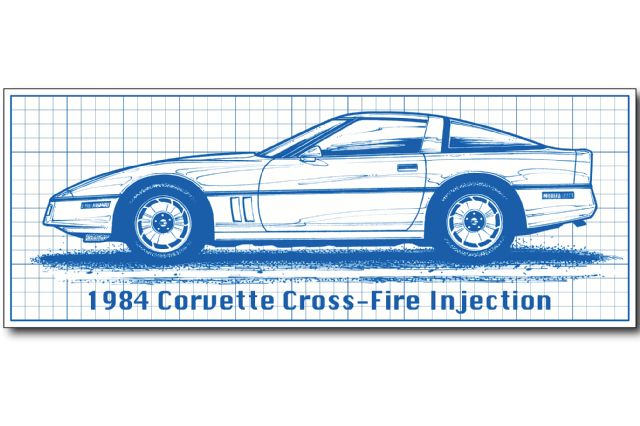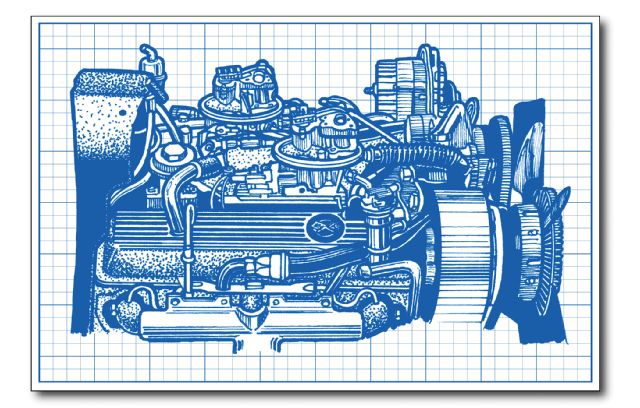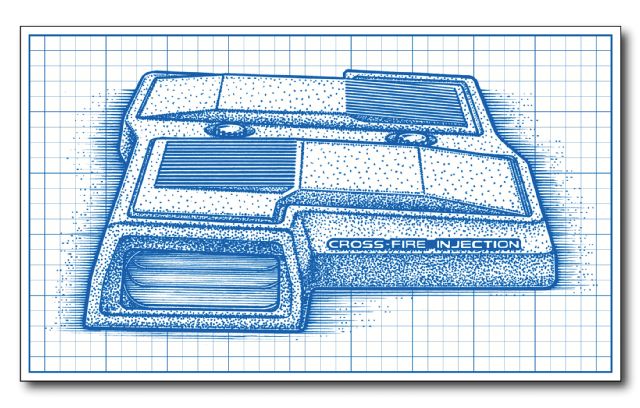
The Illustrated Corvette Designer Series No. 212
Words and Art By Scott Teeters as Written for Vette Magazine, republished from SuperChevy.com
1982 was a serious year of challenges facing Dave McLellan and his design team with several interesting “firsts.” 1982 was the first year since the ’53-’54 Corvettes that a manual transmission was not available. However, it was the first year that a four-speed automatic with Fourth gear as an overdrive. 1982 was also the first year since 1965 that a fuel-injection system was used and the first time ever that a Corvette had an electronic fuel-injection system.
While the Cross-Fire injection system was a hodgepodge of parts, it was essential for several reasons. Emissions and safety standards were increasing every year and had nearly choked to death every carbureted performance car.
Carbureted induction systems could not deliver the necessary EPA standards for engine certification. So, as the cars put on more weight and their engines were restricted more and more, performance went down the tubes. Electronic fuel injection was simply a requirement. Also in the works was the development of the all-new structure of the C4 Corvette—the first seriously fresh structural redesign of the Corvette since the early ’60s! A contributing factor to the adoption of the Cross-Fire injection system was the fact that the hood height of the new C4 was lower than that of the C3—so the engine had to be shorter. “How” they made it all work was amazing.
McLellan and his team made it all happen thanks to ingenuity and GM’s parts bin. The two main features of the Cross-Fire injection system were the unique Trans-Am racing intake manifold and two fuel injectors, the same as used on select ’81 Cadillacs. On the ’81 Corvette a single injector was inserted into the Rochester carburetor to help the engine to pass emissions, but it was still a carbureted engine. The top plate of the Trans-Am manifold was modified to take two injectors where the racing carbs would have been. While the manifold performed well for a high-rpm racing application, it wasn’t happy under low speed, normal driving conditions. According to Chief Engineer Dave McLellan, “The flat Trans-Am manifold gave such poor cylinder-to-cylinder distribution that we had to compensate with more fuel.”

The dual fuel injectors were controlled by Chevrolet’s latest Computer Command Control unit that delivered 80 spurts per-second, instead of the 10 delivered by its predecessor. The computer took inputs from the throttle position, coolant temperature, engine vacuum, ignition timing, and oxygen sensors. In response to the gathered data, the electric fuel pump, mounted inside the fuel tank, varied the pump pressure between 9 and 13 psi. Then, solenoids above the two fuel injector units operated the fuel injectors. It was all a balanced dance between electronic pulses and mechanical devices. It was as simple as an electronic fuel-injection system as there could be.
Many less-advanced, hot rod-type features were incorporated into the ’82 Corvette. A solenoid-operated cold-air induction system was integrated into the hood. The exhaust system used a smaller, lighter catalytic converter and the exhaust pipe from the manifold to the converter was redesigned to deliver hotter exhaust to the converter for better efficiency. And a small-diameter fan was used. When the ’82 model was completed and ready for sale, the L81 Cross-Fire injection engine was rated at 200 horsepower, up 10 from the ’81 engine.

“Performance” was … well, let’s not go there, except to say that most road tests of the ’82 model consistently reported that driveability and throttle response was much improved, as well as fuel mileage. In general, the ’82 Corvette was a “nice car” and the Collector Edition was a beauty. The L81 Cross-Fire injection engine served its purpose—it got certified for production and the slightly improved ’84 version delivered enough grunt to wow the press in the new and vastly improved C4. However, when the L81 was replaced with the for-real fuel-injected L98 in ’85, no one shed a tear for the Cross-Fire injection engine.
